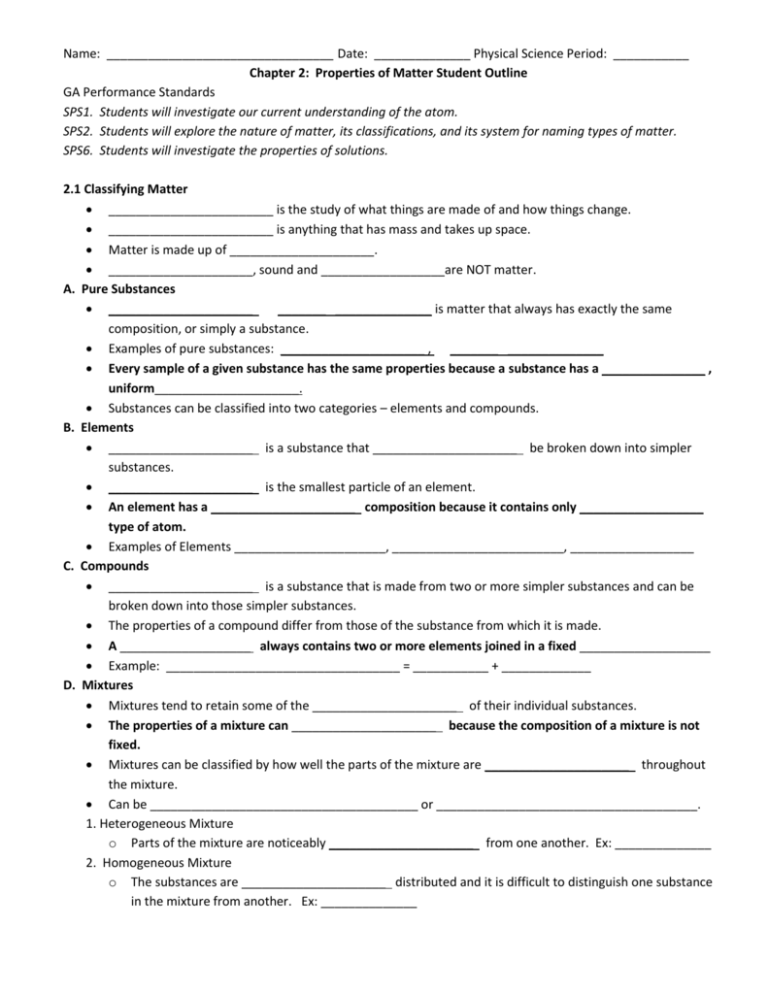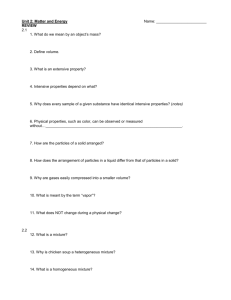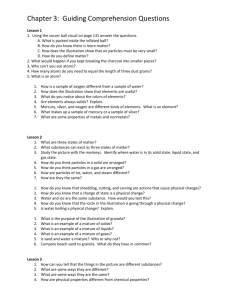Name: Date: Physical Science Period: ______ Chapter 2: Properties
advertisement

Name: _________________________________ Date: ______________ Physical Science Period: ___________ Chapter 2: Properties of Matter Student Outline GA Performance Standards SPS1. Students will investigate our current understanding of the atom. SPS2. Students will explore the nature of matter, its classifications, and its system for naming types of matter. SPS6. Students will investigate the properties of solutions. 2.1 Classifying Matter ________________________ is the study of what things are made of and how things change. ________________________ is anything that has mass and takes up space. Matter is made up of _____________________. _____________________, sound and __________________are NOT matter. A. Pure Substances _____________________ _______ ______________ is matter that always has exactly the same composition, or simply a substance. Examples of pure substances: _____________________ , _______ ______________ Every sample of a given substance has the same properties because a substance has a _______________ , uniform_____________________. Substances can be classified into two categories – elements and compounds. B. Elements _____________________ is a substance that _____________________ be broken down into simpler substances. _____________________ is the smallest particle of an element. An element has a _____________________ composition because it contains only __________________ type of atom. Examples of Elements ______________________, _________________________, __________________ C. Compounds _____________________ is a substance that is made from two or more simpler substances and can be broken down into those simpler substances. The properties of a compound differ from those of the substance from which it is made. A ___________________ always contains two or more elements joined in a fixed ___________________ Example: __________________________________ = ___________ + _____________ D. Mixtures Mixtures tend to retain some of the _____________________ of their individual substances. The properties of a mixture can _____________________ because the composition of a mixture is not fixed. Mixtures can be classified by how well the parts of the mixture are _____________________ throughout the mixture. Can be _______________________________________ or ______________________________________. 1. Heterogeneous Mixture o Parts of the mixture are noticeably _____________________ from one another. Ex: ______________ 2. Homogeneous Mixture o The substances are _____________________ distributed and it is difficult to distinguish one substance in the mixture from another. Ex: ______________ E. Solutions, Suspensions, and Colloids The size of the particles in a mixture has an effect on the properties of the mixture. Based on the size of its largest particles, a mixture can be classified as a solution, a suspension, or a colloid. 1. Solutions o Placing a spoonful of sugar in a glass of hot water and stirring will dissolve the water and make a homogeneous mixture. o _____________________ forms when a substance dissolves and forms a homogeneous mixture. o Example: _____________________ or tea 2. Suspensions o _____________________ is a heterogeneous mixture that separates into layers over time. o Examples: salad dressing, _____________________ and _____________________ o Because larger particles can _____________________ light in all direction suspensions are _____________________. 3. Colloids o _____________________ contains some particles that are intermediate in size between the small particles in a solution and the larger particles in a suspension. o Milk is a mixture of substances including water, sugar, proteins and fats. o Colloids do _____________________ separate into_____________________ . o _____________________ is a colloid of water droplets in air. Summary: 2.2 Physical Properties A. Examples of Physical Properties _____________________ _____________________ is any characteristic of a material that can be observed or measured without changing the composition of the substances in the material. Viscosity, conductivity, malleability, hardness, melting point, boiling point, and density are examples of physical properties. 1. Viscosity o _____________________ is the tendency of a liquid to keep from flowing (its resistance to flowing). o the _____________________ the viscosity the_____________________ the liquid moves. o honey and corn syrup have _____________________ viscosity and vinegar has __________________ viscosity. o Viscosity will _____________________ when it is _____________________ . 2. Conductivity o _____________________ is a material’s ability to allow heat to flow o Metals have high conductivity and are _____________________ o _____________________ will not conduct heat and make a great spoon 3. Malleability o _____________________ is the ability of a solid to be hammered in to sheets (or shapes) without shattering o Most _____________________ are malleable o Solids that _____________________ when struck are_____________________ 4. Hardness o One way to compare the hardness of two materials is to see which of the materials can _____________________ the other o _____________________ is the hardest known material 5. Melding and Boiling Points o _____________________ _____________________ is the temperature at which a substance changes from solid to liquid. o Melting point for water is 0C o _____________________ _____________________ is the temperature at which a substance boils o Boiling point of water is 100C 6. Density o Recall that _____________________ is the ratio of the mass of a substance to its volume o Density can be used to test the purity of a substance B. Using Physical Properties Physicals properties are used to_____________________ a material, to choose a material for a specific purpose or to separate the substances in a mixture. C. Using Properties to Separate Mixtures Filtration and distillation are two common separation methods 1. Filtration o _____________________ is a process that separates materials bases on the size of their particles o Example: tea leaves caught in a strainer when making tea 2. Distillation o _____________________ is a process that separates the substances in a solution bases on their boiling points o A practical use of distillation is to provide freshwater for submarines D. Recognizing Physical Changes _____________________ _____________________ occurs when some of the properties of a material change, but the substances in the material remain the same Heating butter until it melts, crumpling a piece of paper, slicing a tomato Some physical changes can be_____________________ : _____________________ and_____________________ Some physical changes can_____________________ be reversed: reforming a whole tomato from its slices 2.3 Chemical Properties A. Observing Chemical Properties _____________________ _____________________ is any ability to produce a change in the composition of matter Chemical properties can be observed only when the substances is a sample of matter are_____________________ into _____________________ substances 1. Flammability o _____________________ is a material’s ability to burn in the presence of oxygen o Example: burning newspapers to start a fire 2. Reactivity o _____________________ describes how readily a substance combines chemically with other substances o Oxygen is highly reactive element and reacts easily with most other elements o Oxygen reacts with iron and water to form rust o Nitrogen has low reactivity and can be used inside tanks to limit rust formation B. Recognizing Chemical Changes _____________________ _____________________ occurs when a substance reacts and forms one or more new substances three common types of evidence for a chemical change are a change in color, the production of a gas, and the formation of a precipitate. 1. A change in_____________________ o a change in color is a clue that a chemical change has _____________________ at least one new substance o silver that _____________________ over time, copper roof changing from red to green when exposed to water 2. Production of a _____________________ o _____________________ of gas forming when u mix vinegar and baking soda is a sign that a chemical change occurred 3. Formation of a Precipitate o _____________________ is a solid that forms and separates from a liquid mixture o adding lemon juice to milk will form some white _____________________ C. Is a Change Chemical or Physical? Ask yourself: are different substances present after the changes takes place NO=physical change, yes= chemical change When matter undergoes a chemical change the composition of the matter changes When mater undergoes a physical change the composition of the matter remains the same. Chapter 3: States of Matter Student Notes GA Performance Standards SPS5. Students will compare and contrast the phases of matter as they relate to atomic and molecular motion. a. compare and contrast the atomic/molecular motion of solids, liquids, gasses and plasmas. b. relate temperature, pressure, and volume of gases to the behavior of gasses SPS7. Students will relate transformations and flow of energy within a system. d. Explain the flow of energy in a phase changes through the use of a phase diagram. 3.1 Solids, Liquids, and Gases A. Describing the States of Matter Materials can be classified as solids, liquids, or gases based on whether their_________________ and _________________ are definite or variable Frequently referred to as the _________________ of matter or _________________ of matter 1. Solids o _________________ is the state of matter in which materials have a_________________shape and _________________ volume o The shape and volume of a solid will _________________ change o Almost all solids have some type of _________________ _________________of particles at the atomic level 2. Liquids o _________________is the stage of matter in which a material has a _________________ volume but a _________________ shape o A liquid always has the same shape as its container and can be poured from one container to another o The arrangement is more random then in a solid. 3. Gases o _________________is the state of matter in which a material has _________________ shape and _________________volume . o A gas takes the _________________and volume of its container o The atoms are _________________ arranged in a regular _________________, and they are at random locations throughout the container 4. Other Stats of Matter o 99% of all matter in the universe exists in a state that is not as common on Earth o _________________ exist at extremely_________________temperatures ,such as on the sun or on stars o Plasma is a gas-like substance of charged particles; traveling very fast o plasma found on earth during _________________. B. Kinetic Theory __________________________________is the energy an object has due to its motion the _________________ the object moves the _________________ its kinetic energy is the kinetic theory of matter says that_________________particles of matter are in _________________ motion These tiny particles are always in motion. The higher the temperature, the faster the particles move. At the same temperature, more massive (_________________) particles move _________________ than less massive (lighter) particles. C. Explaining the Behavior of Gases The particles in a gas are _________________ at _________________ Particles in a gas are in constant, _________________motion The constant motion of particles in a gas allows a gas to fill a container of any shape or size The motion of one particle is _________________ by the motion of other particles unless the particles collide Forces of _________________ among particles in a gas can be_________________ under ordinary conditions D. Explaining the Behavior of Liquids The particles in a liquid are __________________________________packed than the particles in a gas The attractions between the particles in a liquid _________________ affect the movement of the particles A liquid takes the _________________ of its container because the particles in a liquid can flow to new locations. The _________________ of a liquid is _________________ because forces of attraction keep the particles close together. E. Explaining the Behavior of Solids Solids have a _________________ volume and shape because particles in a solid_________________ around_________________locations Vibration is a repetitive back and forth motion Each atom vibrates around its location but it does not exchange places with a neighboring atom F. Illustrations and summary of phases of matter Solid Phase Solid Liquid Gas Summary of Phases of Matter Shape Volume Liquid Gas G. Reading data table practice Substance Melting Point Boiling Point Rubbing Alcohol - 89 °C 82.5 °C Salt 801 °C 1413 °C Water 0 °C 100 °C Baking soda 50 °C 851 °C 1. What phase of matter is alcohol in at 0 °C? 2. What phase of matter is Salt in at 900 °C? 3. What substances are a gas at 110 °C? 4. What is the freezing point of baking soda? 5. At what temperature is salt a gas? 6. At what temperature range is baking soda a liquid? 3.3 Phase Change A. Characteristics of Phase changes __________________________________is the _________________ physical change that occurs when a substance changes form one_________________of matter to another Melting, freezing, vaporization, condensation, sublimation, and deposition are six common phase changes All phase changes share certain characteristics related to_________________and_________________ B. Temperature and Phases Changes One way to recognize a phase change is by measuring the temperature of the substances as it is heated or cooled The _________________ of a substance does _________________change during a phase _________________ Temperature remains _________________during a phase change 1. Energy and Phase Changes o During a phase change, energy is transferred between a substance and its surroundings o Energy is either absorbed or released during a phase change o __________________________________the system absorbs energy from its surroundings o __________________________________the system releases energy to its surroundings C. Melting and Freezing The arrangement of molecules in water become less orderly as water melts and more orderly as water freezes. 1. Melting • _________________ is when energy is added to a _________________object and it turns into a_________________. • The average kinetic energy of the molecules increase and the temperature rises • This is ENDOTHERMIC 2. Freezing o _________________ is when energy is removed form an object and it goes form a _________________ to a _________________ o As the average kinetic energy decreases, the molecule move more slowly o This is EXOTHERMIC D. Vaporization and Condensation 1. Boiling o _________________ (_________________) is when a substance changes form a_________________into a_________________ o Vaporization is an endothermic process, the substance has to absorb energy to change from a liquid to a gas o As the temperature increases the molecules move faster and faster o This is ENDOTHERMIC 2. Condensation o _________________ is the phase change in which a substance changes from a _________________ or vapor to a _________________ o Condensation is an EXEOTHERMIC process E. Sublimation and Deposition _________________ is the phase change in which a substance changes form a _________________ to a_________________or vapor without changing to a liquid first Dry Ice (solid carbon dioxide) at room temperature goes from solid to gas and forms a “fog” Sublimation is ENDOTHERMIC _________________ is when a_________________or vapor changes directly into a_________________without first changing to a liquid Deposition causes frost to form on windows This is EXOTHERMIC Phase Change Diagram Phase Change Diagram Practice What is occurring at the following points o Point A o Point B What phases is present at the following points o Point A o Point B o Point C o Point D o Point E 3.2 the Gas Laws A. Pressure • ___________________________ is the result of a force distributed over an ___________________________ • Pressure is a gas is produced by the gas atoms colliding with a wall • ___________________________ between particles of a gas and the walls of the container ___________________________ the ___________________________ in a closed container of gas • The more frequent the collisions the greater the pressure of the gas B Factors that Affect Gas Pressure • Factors that affect the pressure of an enclosed gas are its temperature, its volume, and the number of its particles. 1. Temperature • As the ___________________________ rises, the average ___________________________ ___________________________of the particles in the air increases • The particles move faster and collide more often. • ___________________________ the ___________________________ of a gas will ___________________________its ___________________________ if the volume of the gas and the number of particles are constant 2. Volume • ___________________________the volume of a gas ___________________________ its ___________________________ if the temperature of the gas and the number of particles are constant 3. Number of Particles • The ___________________________ particles there are in the same volume, the greater the number of collisions and the ___________________________ the ___________________________ • Increasing the number of particles will ___________________________ the ___________________________ of a gas if the temperature and the volume are constant C. Charles’s Law • Jacques Charles showed that as the volume of a gas increases at the same rate as the temperature of the gas • ___________________________states that the ___________________________ of a gas is ___________________________proportional to its ___________________________ in Kelvins if the pressure is constant D. Boyle’s Law • ___________________________states that the ___________________________of a gas is ___________________________proportional to its ___________________________ if the temperature is constant E. Guy-Lussac’s Law • According to ____________________________, for a given amount of gas held at constant volume, the ___________________________ is ___________________________ to the ___________________________ • If one increases the other will increase Gas Law Practice • Pressure is constant: – If temperature increases volume – If temperature decreased volume • Temperature is constant: – If pressure increases volume – If pressure decreases volume • Volume is constant: – If the temperature decreases pressure – If the temperature increases pressure









